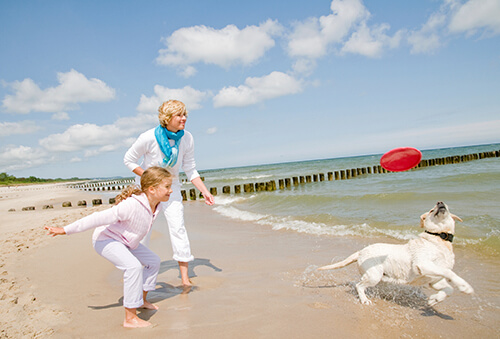Pets quickly take notice of cues the family may give such as putting on shoes or getting a backpack ready before going out the door. Often times these cues will cause a pet to act out excitedly by barking, jumping and displaying other anxious behaviors. These are all signs of the pending separation anxiety your pet is feeling.
Signs of Separation Anxiety
Your pet can display separation anxiety in other ways, too. If you notice an increased number of ‘accidents’ in the home, increased howling or barking, or even trying to escape the home or yard, this may be your pet’s way of displaying that he or she is having a rough time adjusting to the new family schedule.
While pet parents are aware their pet may be feeling anxious about their absence, many might not be aware of the things that can help to put their pets at ease.
What You Can Do to Help
Ease Into It
One great exercise a family can do is to adjust their pets to the new schedule gradually. For instance, in the first couple of weeks leading up to a drastic schedule change, a family can help the pet adjust by leaving the home for short amounts of time, then gradually lengthening that time away. This way your pet can get used to the idea that everybody will be gone, but still be reassured of their return.
Keep it short
When it comes to leaving the house, a short goodbye is always better than a drawn out process. It is a good idea to have everything you need ready by the door and when it comes time to leave, just grab everything and go. If you spend time feeling bad about leaving the pet, it can increase their anxiety levels and make your leaving harder on them. By keeping things brief and upbeat, your pet will get the message that leaving isn’t a big deal and they can better look forward to the family’s return. You can even keep treats handy by the door to create a positive association with your exit rather than something to be dreaded.
Keep them occupied while you're away
Another great way to ease their anxiety is to leave them something stimulating during your absence. A rubber toy filled with
peanut butter and left in the freezer to harden will keep a dog busy for quite a while. You can also leave a number of their favorite toys out to play with while you’re gone. Classical music left on the radio along with soothing scents can also be used to keep your pet’s mind at ease.
Get lots of exercise
And the best way to alleviate symptoms of separation anxiety is to give your pet plenty of exercise. Not only does vigorous exercise release the endorphins that help keep a pet happy and healthy, but tired muscles equal a tired pet, and tired pets are more likely to sleep while you’re away. Exercise and play are great bonding experiences between pets and their parents and the closer the bond between you and your pet, the more likely they are to remain stress- and anxiety-free during your absence.






